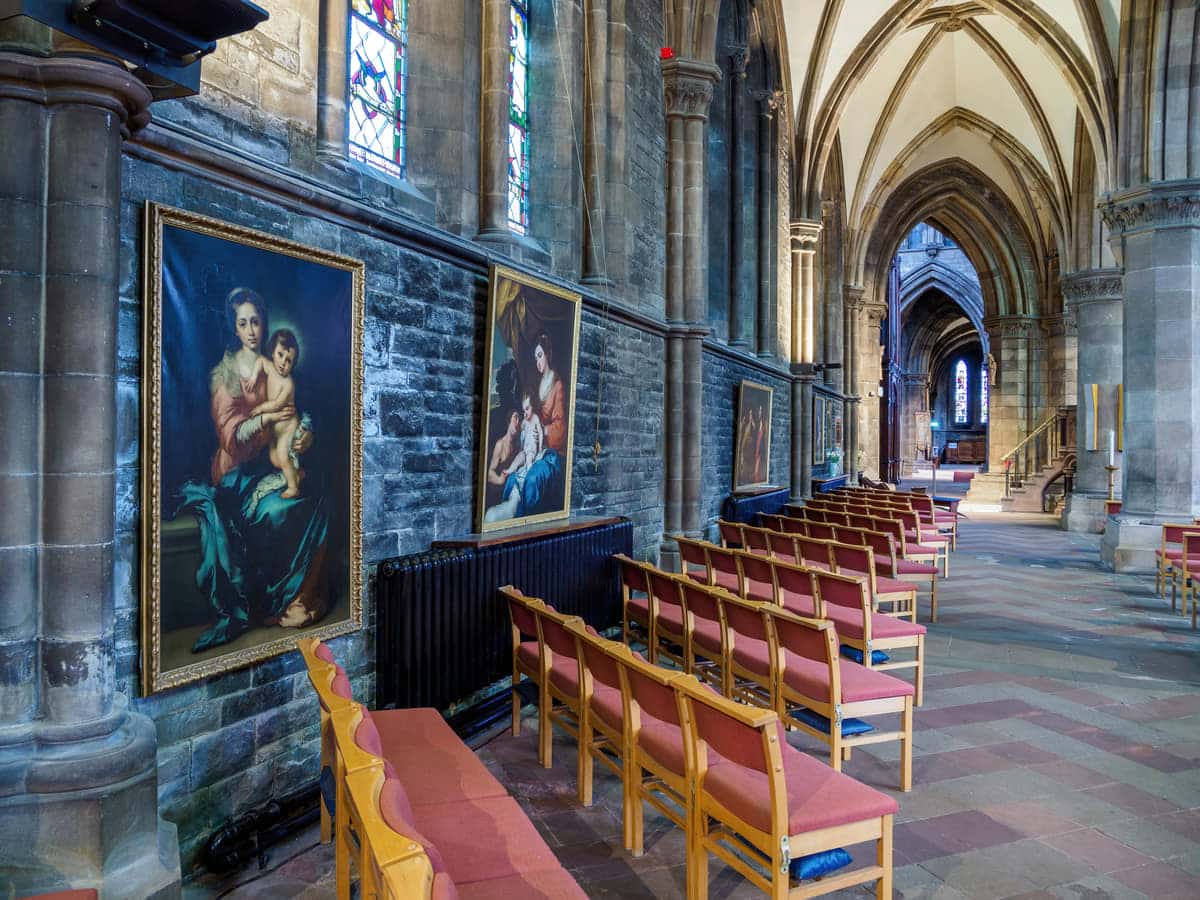In this article, you’ll discover the magnificent St. Mary’s Episcopal Cathedral, an architectural gem nestled in the heart of Edinburgh’s New Town. This awe-inspiring building, with its soaring spires and intricate stonework, has been an integral part of the city’s skyline since its consecration in 1879.
Though it’s the largest religious site in the city it’s regarded as one of Edinburgh’s true hidden gems due to its location on Palmerston Place in the West End – an area not usually visited by tourists. Even so, visitors are welcome to see this beautiful cathedral year-round and entry is completely free of charge.

| Address: | Palmerston Place, Edinburgh, EH12 5AW |
| Opening Hours: | Open from 8am to 6pm every weekday and 8am to 5pm on Saturday and Sunday |
| Admission Price: | Free entry |
| Parking: | No on-site car park |
| Contact: | Tel: 01312256293 email: office@cathedral.net |
| Facilities: | Toilets |
| Photos: | Virtual Tour YouTube Video |
Overview
St. Mary’s Episcopal Cathedral is a magnificent landmark located in the heart of Edinburgh’s New Town. Built between 1874 and 1879, this stunning cathedral is well known for its striking architecture.
The history of the cathedral dates back to the 17th century, when Episcopalians were replaced by Presbyterians as the dominant members of the Church of Scotland. This led to the founding of the Scottish Episcopal Church, which needed a central place of worship in Edinburgh that was larger than the old woollen mill that had been previously used to house their rapidly expanding congregation.
The Duke of Buccleuch laid the foundation stone for the church in 1874 after commissioning renowned British architect Sir George Gilbert Scott, who had designed numerous churches and cathedrals throughout Britain.
The cathedral was consecrated on October 30, 1879, but it wasn’t fully completed until 1917, when twin spires were added to the western end, making the cathedral one of only three in Britain that has three spires (the others are in Lichfield and Truro).
These spires are remarkable feats of engineering as they house 12 bells in total, including a tenor bell that weighs more than 2 tonnes. Even today, the main spire dominates the city skyline as it’s a remarkable 295 feet (90 metres) high, making St. Mary’s Episcopal Cathedral the tallest building in Edinburgh.

Interestingly, the two additional spires are named Barbara and Mary after the two sisters from the wealthy Walker family who originally donated the land on which the cathedral is located, and they were designed by the grandson of architect George Gilbert Scott, who built the main cathedral building.
When you visit St. Mary’s you’ll be immediately struck by its architecture as it’s an outstanding example of Gothic Revival – a style made popular in the 19th century which sought to revive the spirit of medieval Gothic architecture.
But as beautiful as the exterior is, it’s nothing compared to the interior, which features intricate stone carvings, beautiful stained-glass windows, and an impressive nave supported by soaring stone columns.
There are four main entrance doors, but the one used by visitors is situated on Palmerston Place, which is impossible to miss as there’s a giant key sculpture outside (representing the key to the Kingdom of Heaven). Once through the door, you can’t fail to be impressed by the size of the place as well as a couple of features that are nothing short of stunning.
The first is the Paolozzi Millenium Window which is inset with dozens of multi-coloured pieces of glass arranged in an elaborate pattern. Visit on a grey day, and it’s nothing special to look at, but visit on a bright, sunny day, and you’ll see the window showering the cathedral’s interior with a kaleidoscope of shimmering colours that are nothing short of spectacular.

Another noteworthy feature of St. Mary’s is the High Altar, the centrepiece of the cathedral which comprises a marble relief of the scene around the Cross at Calvary, set behind an enormous stained glass window. There’s a smaller chapel on one side of the altar, while the other side is home to the cathedral’s organ, which was built in 1879 and is widely regarded as one of the finest in Scotland.
The organ is one of the few in the country that’s still used multiple times throughout the week as St. Mary’s Cathedral is the only one in the country that maintains the tradition of daily choral services. These services are a major draw for tourists as the cathedral boasts a talented choir that performs during services and at various events throughout the year, while during the summer months, other choirs travel to St. Mary’s Cathedral to make use of its extraordinary acoustics.
In addition to its religious services, St. Mary’s is known for its extensive music programme, which includes organ recitals and performances by visiting musicians from around the world. The cathedral also hosts a variety of cultural events, including lectures and workshops, and it’s a major venue for the annual Edinburgh Fringe Festival.

The Highlights
1: As the cathedral is slightly off the standard tourist trail it sees far fewer visitors than historic buildings like St. Giles Cathedral, meaning you can explore it without having to barge your way through heaving crowds. It’s also free to get in, so for a cheap afternoon of sightseeing, you might like to combine it with the nearby Parish Church of St. Cuthbert which also has free entry.
2: St Mary’s Cathedral is stunning and is (in my opinion at least) one of the most attractive buildings in Edinburgh. The 10-minute walk from Princes Street is well worth the effort for shutterbugs and history buffs alike.
3: There are a couple of noteworthy features inside the cathedral including the High Altar, the Paolozzi window, and the pipe organ. The Paolozzi window is stunning on a sunny day as it projects multi-coloured lights onto the surrounding pillars.
Visiting Tips
1: Car parking is nigh-on impossible in this part of the West End as most spaces are for permit holders only, although you might be able to find a space on Melville Street which has paid parking spaces (postcode EH3 7HF). That being said, the best option to get to the cathedral is to walk from Princes Street, which is around 10 minutes away.
2: If you’re feeling peckish after a visit to the cathedral it’s quicker to head to Haymarket station (postcode EH12 5EY) than Princes Street as there are lots of cafes in the area. You can then catch a train, tram, or bus back to the city centre.
3: Another gem of an attraction in the West End is the National Gallery of Modern Art which is a 10-minute walk from St. Mary’s Cathedral. Head north along Palmerston Place and turn onto Belford Road. The gallery is straight ahead.

Tourist Information
Finding St. Mary’s Episcopal Cathedral can be a wee bit tricky for first-time city sightseers so I suggest using Google Maps as it’s a good 10-minute walk from the main tourist areas. Note that there are actually two ‘St. Mary’s’ in Edinburgh, the second being St. Mary’s Catholic Cathedral, which is located on York Place near the OMNi Centre.
Visitors are welcome inside the Catholic cathedral as well as the Episcopal one, so if cathedrals interest you, you might like to combine them with St. Giles Cathedral on the Royal Mile, though be prepared for a long walk between all three sites.
As already mentioned, the Episcopal Cathedral is completely free to visit, but there are very few visitor facilities inside apart from toilets. As Haymarket is just a couple of minute’s walk away, you’ll have no problems finding umpteen places nearby for food if you’re feeling peckish.
Once you’ve wandered around the interior of the cathedral and admired it (expect to take around 30 minutes) I recommend having a look around the exterior as it’s quite a sight to behold and is a must-visit for any tourist with a camera.
To the rear of the cathedral, you’ll notice another building, the Song School, which was built in 1885 as a place for the choir to practice and has been in constant use since that time. Though it’s not strictly open to tourists, it does open its doors at certain times of the year for guided tours, although the building next to it, the Old Coates House, is strictly private as it’s used as a local nursery school.

Things to Do
Attend a Service: St Mary’s Episcopal Cathedral is a place of worship, so attending a service there is a must for religious visitors. The cathedral is well known for its music and the award-winning choir often performs during services. The spiritual atmosphere of this beautiful cathedral definitely provides a unique experience.
Explore the Architecture: The cathedral, built in the late 19th century, boasts of stunning Gothic Revival architecture. You can spend time admiring the intricate carvings, stained glass windows, and one of the tallest church spires in Scotland.
Self-Guided Tour: Take a walk around the cathedral with a guidebook and explore the history, architecture, and religious significance of the building. If you’d like to read about its history online, visit the official website.
Visit the Song School: Located within the cathedral, the Song School features beautiful murals by Phoebe Anna Traquair. It’s a lesser-known gem which is definitely worth seeing, but note that it’s only opened up to the public by prior request.
Listen to a Concert: The cathedral often hosts concerts and music events, thanks to its excellent acoustics. Check their schedule to enjoy a soothing classical music concert, the highlights usually happening during the Fringe festival in August.

Things to Do Nearby
The Water of Leith Walkway. Damside, Edinburgh EH4 3BE. 0.4 miles.
The Water of Leith is a river that starts in the Colzium Hills outside of Edinburgh and flows all the way to Leith on the far east side of the city. The river walkway is a popular venue for locals as it’s a natural oasis of wildlife and plants away from the hubbub of the city centre. The majority of the section within Edinburgh has paved pathways that are suitable for use by all ages and abilities.
Scottish National Gallery of Modern Art. 75 Belford Rd, Edinburgh EH4 3DR. 0.5 miles.
This gallery is divided into two buildings – Modern One and Modern Two – and both feature a range of displays and exhibits by famous artists from the 20th and 21st centuries. There are both free and paid exhibitions, most of which rotate exhibits throughout the year. Facilities in the National Gallery of Modern Art include a cafe and a gift shop.
Dean Village. Address: Dean Path, Edinburgh, EH4 3AY. Distance: 0.5 miles.
Dean Village, a picturesque gem in Edinburgh, boasts a rich history and stunning architecture. Once a thriving milling area, it now offers a tranquil escape from city life for tourists and locals alike. Walk along the Water of Leith, admire the historic buildings of Well Court, visit the iconic Dean Bridge, and then take a walk through the sprawling Dean Cemetery for a superb wee sightseeing tour.
Johnnie Walker Princes Street. Address: 145 Princes Street, Edinburgh, EH2 4BL. Distance: 0.5 miles.
This is one of Edinburgh’s newest tourist attractions, combining a whisky shopping experience with tours and tastings of Johnnie Walker whisky in an on-site bar.
The Georgian House. 7 Charlotte Square, Edinburgh, EH2 4DR, is a 19-minute walk.
Adam Smith, an architect, created the Georgian House, a opulent townhouse. Visitors can explore rooms that have been restored to the same condition they were in when wealthy Edinburgh families lived in the house in the 1700s. The house is managed by the National Trust for Scotland, so there is an entry fee unless you are an NTS member. Join the National Trust for Scotland.
Frequently Asked Questions
Can you get married at St Mary’s Cathedral?
Yes, you can get married at St Mary’s Cathedral in Edinburgh. The cathedral is a beautiful and historic venue that hosts wedding ceremonies throughout the year except for August. It is advised to contact the cathedral directly to inquire about availability and any specific requirements for your wedding ceremony.
Who is buried in St Mary’s Cathedral?
St.. Mary’s Cathedral in Edinburgh, also known as the Cathedral Church of Saint Mary the Virgin, is a cathedral of the Scottish Episcopal Church. It is not known for being a burial site forr any specific individual. The cathedral is primarily a place of worship and a centre for choral and organ music.
Who built St Mary’s Cathedral?
Sir George Gilbert Scott, an architect, created St. Mary’s Cathedral in Edinburgh, also known as the Cathedral Church of Saint Mary the Virgin. Construction began in 1874, and the cathedral was consecrated in 1879.
When was St. Mary’s Episcopal Cathedral destroyed?
St Mary’s Cathedral in Edinburgh, also known as the Cathedral Church of Saint Mary the Virgin, has never been destroyed. It was built in the late 19th century between 1874 and 1879. It remains standing today as an important landmark in Edinburgh.







